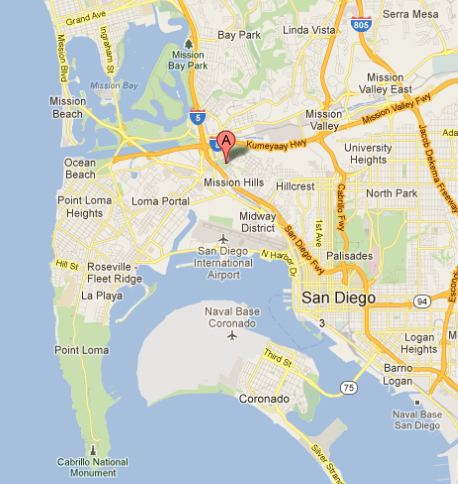 Within Old Town San Diego State Historic Park (San Diego Historical Landmark #14) are many historic buildings and rebuilds. We’ll explore nine of them since they also have been designated San Diego Historical Landmarks.
Within Old Town San Diego State Historic Park (San Diego Historical Landmark #14) are many historic buildings and rebuilds. We’ll explore nine of them since they also have been designated San Diego Historical Landmarks.
The eighth landmark within Old Town is the Mason Street School:.
![]()
 A marker outside the museum (picture►) says that it was named “Mason Screen School, District No. 1) and was built in 1865.
A marker outside the museum (picture►) says that it was named “Mason Screen School, District No. 1) and was built in 1865.
Not only was it the first public school in San Diego, but in all of San Diego County as well, which, in 1865, was twice as large as it is today. No two boards were the same width or length, so presumably they tore down various abandoned structures and salvaged the lumber to build the schoolhouse.
School was in session 12 months of the year and school hours
were from 9 a.m. to 4 p.m. Attendance averaged 35 students of age 4 to 17. All eight grades were taught in one room. Since very few families owned clocks, school tardiness was the rule rather than the exception.
Heat was supplied by an iron stove and indoor plumbing was a water bucket with a dipper. Outdoor toilets were provided with a new moon crescent cut into the door to signify girls and a round hole (sun) indicating boys.
Mary Chase Walker (1828-1899) was the first teacher, earning a monthly salary of $65. After just eleven months she quit teaching. Maybe she had too many juvenile delinquents like one Russel Ray and just couldn’t handle them all….
….or maybe she married Ephraim Morse, who was president of the school board at the time.
(Reminds my of my mom’s dad. While married to his first wife, he had an affair with one of his students, got divorced, married her, and proceeded to have five more children.)
 Mary Chase Walker (picture►) was born in Methuen, Massachusetts, and began her teaching career in Groton, New Hampshire, when she was only 15 years old.
Mary Chase Walker (picture►) was born in Methuen, Massachusetts, and began her teaching career in Groton, New Hampshire, when she was only 15 years old.
On April 1, 1865, she took a steamship from New York to San Francisco, costing $375 for a 4-week voyage. Although there were no teaching jobs
in San Francisco she was told that
San Diego needed a teacher for its new school. She arrived in San Diego on
July 5, 1865, to what was, she says,
“a most desolate looking landscape. The hills were brown and barren; not a tree or green thing was to be seen. Of all the dilapidated, miserable looking places I had ever seen, this was the worst. The buildings were nearly all of adobe, one story in height, with no chimneys. Some of the roofs were covered with tile and some with earth.
“The first night of my stay at the hotel, a donkey came
under my window and saluted me with an unearthly bray.
The fleas were plentiful and hungry. Mosquitoes were also
in attendance.”
About the school she said:
“My school was composed mostly of Spanish and half-breed children, with a few English and several Americans. I aimed to teach which was most meaningful to them; namely reading, spelling, arithmetic, and how to write letters. At recess the Spanish girls smoked cigaritas and the boys amused themselves by lassoing pigs, hens, etc. The Spanish children were very irregular in their attendance at school on account of so many fiestas and amusements of various kinds. For a week before a bull fight the boys were more or less absent, watching preparations, such as fencing up the streets leading to the plaza.”
Her story gets even more interesting, though, when she invited a black woman to lunch at the Franklin House. Some diners stormed out while others stared with contempt. Many parents removed their children from the school, and enrollment plunged from
36 students to 15.
After she left teaching, she supported the suffragette movement and worked to help the most needy. She died in San Diego on
May 17, 1899.
The Mason Street School Museum is open daily from 10:00 a.m.
to 4:00 p.m. Admission is free.
Various resources say that they have adult education class in California history, and fourth grade tours. Inquiring minds want to know why just fourth grade?
![]()
For the introductory blog post to San Diego’s historical landmarks, click on San Diego’s Historical Landmarks.
For previous posts in the San Diego Historical Landmarks series, go here.
![]()
Need a unique gift? Anniversary? Birthday? Graduation? Marriage? Choose Photographic Art by Russel Ray Photos at Fine Art America.
![]()






How nice they’ve saved the old building and local history. Those are important. Laughed at her comments about the school…People ought to reconsider ow she determined what to teach them. (Those teachers – always the strong willed hot heads..giggles)
Maybe 4th grade is when school kids study state history? It is here.
Back in that era, many school boards insisted all teachers be unmarried. The thought was a married woman wouldn’t have time for working (planning lessons, grading,tutoring) outside the home without depriving her own family.
Cool post, Russel
LikeLiked by 1 person
Ah-ha! I hadn’t considered that fourth grade might be when they studied state and local history.
LikeLike
Fascinating stuff! Mary, bless her, looks somewhat formidable, doesn’t she? I imagine a strong right arm might have been an ingredient of her curriculum. I’m immersed in Steinbeck at the moment, very much a writer chronicling those times, and I noticed in East of Eden how he described schoolteachers as people of status who could be expected to marry well. I hope Mary did.
LikeLiked by 1 person
Eleven months after she quit teaching, she married the head of the School Board. Incest?……..LOL
LikeLiked by 1 person
I love a story behind a story. Thanks for sharing 🙂
LikeLiked by 1 person
This post went nowhere near where I thought it was going when I started it. That’s because there’s very little about the school itself but lots of good stuff about Mary.
LikeLiked by 1 person
I like Miss Walker’s style.
LikeLike
From the looks of Ms. Walker, I would guess juvenile delinquents didn’t last too long.
LikeLiked by 1 person
I thought the same thing and am quite happy that I was not in her class…………LOL
LikeLike